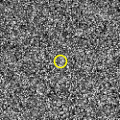Praxidike (moon)
Praxidike or Jupiter XXVII, is a non-spherical moon of Jupiter. It was found by a team of astronomers from the University of Hawaii led by Scott S. Sheppard in 2000,[1][2] and given the designation S/2000 J 7.
Praxidike orbits Jupiter at an average distance of 20,824,000 km in 613.904 days, at an inclination of 144° to the ecliptic (143° to Jupiter's equator), with an orbital eccentricity of 0.1840.
It was named in August 2003 after Praxidike,[3] the Greek goddess of punishment.
Praxidike belongs to the Ananke group, believed to be the remnants of a break-up of a captured asteroid.[4][5] With an estimated diameter of 7 km, Praxidike is the second biggest member of the group after Ananke itself (assumed albedo of 0.04)[6]
The moon appears grey similar to C-type asteroids.[7]
Praxidike (moon) Media
Praxidike observed by the WISE spacecraft in 2010
References
- ↑ IAUC 7555: Satellites of Jupiter 2001 January 5 (discovery)
- ↑ MPEC 2001-A29: S/2000 J 7, S/2000 J 8, S/2000 J 9, S/2000 J 10, S/2000 J 11 2001 January 15 (discovery and ephemeris)
- ↑ IAUC 7998: Satellites of Jupiter 2002 October 22 (naming the moon)
- ↑ Sheppard, S. S., Jewitt, D. C.; An Abundant Population of Small Irregular Satellites Around Jupiter, Nature, Vol. 423 (May 2003), pp. 261-263
- ↑ Nesvorný, D.; Alvarellos, J. L. A.; Dones, L.; and Levison, H. F.; Orbital and Collisional Evolution of the Irregular Satellites Archived 2020-04-15 at the Wayback Machine, The Astronomical Journal, Vol. 126 (2003), pp. 398–429
- ↑ Sheppard, S. S.; Jewitt, D. C.; Porco, C.; Jupiter's Outer Satellites and Trojans, in Jupiter: The Planet, Satellites and Magnetosphere, edited by Fran Bagenal, Timothy E. Dowling, William B. McKinnon, Cambridge Planetary Science, Vol. 1, Cambridge, UK: Cambridge University Press, ISBN 0-521-81808-7, 2004, pp. 263-280
- ↑ Grav, T.; Holman, M. J.; Gladman, B. J.; Aksnes, K.; Photometric Survey of the Irregular Satellites, Icarus, Vol. 166 (2003), pp. 33-45
- Ephemeris IAU-MPC NSES
- Mean orbital parameters NASA JPL
